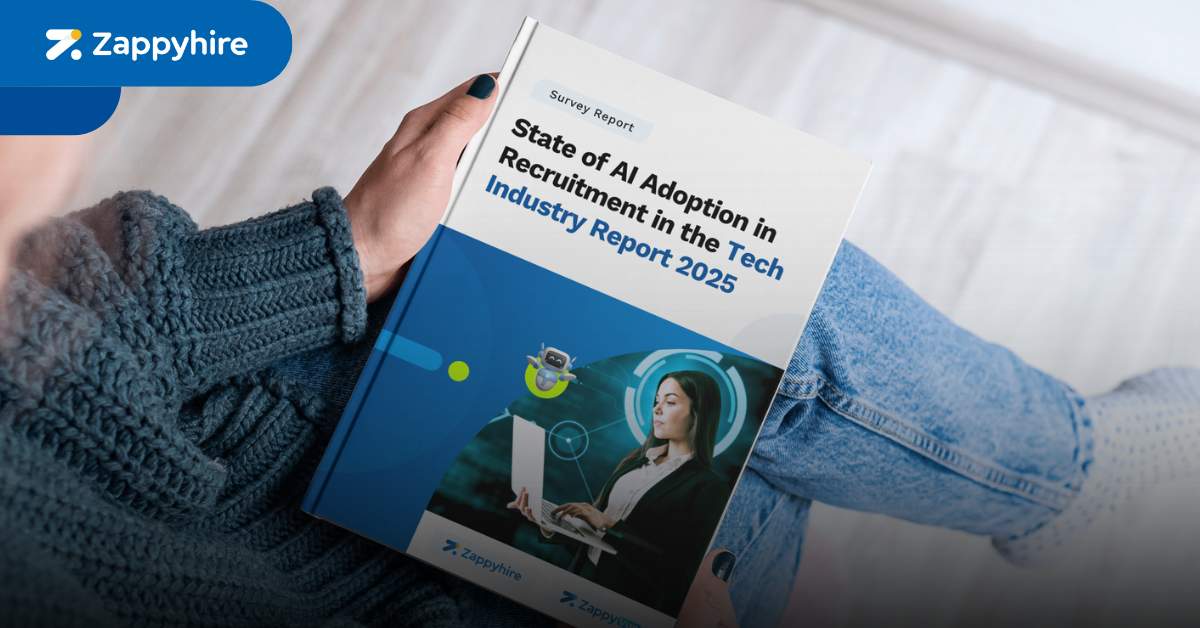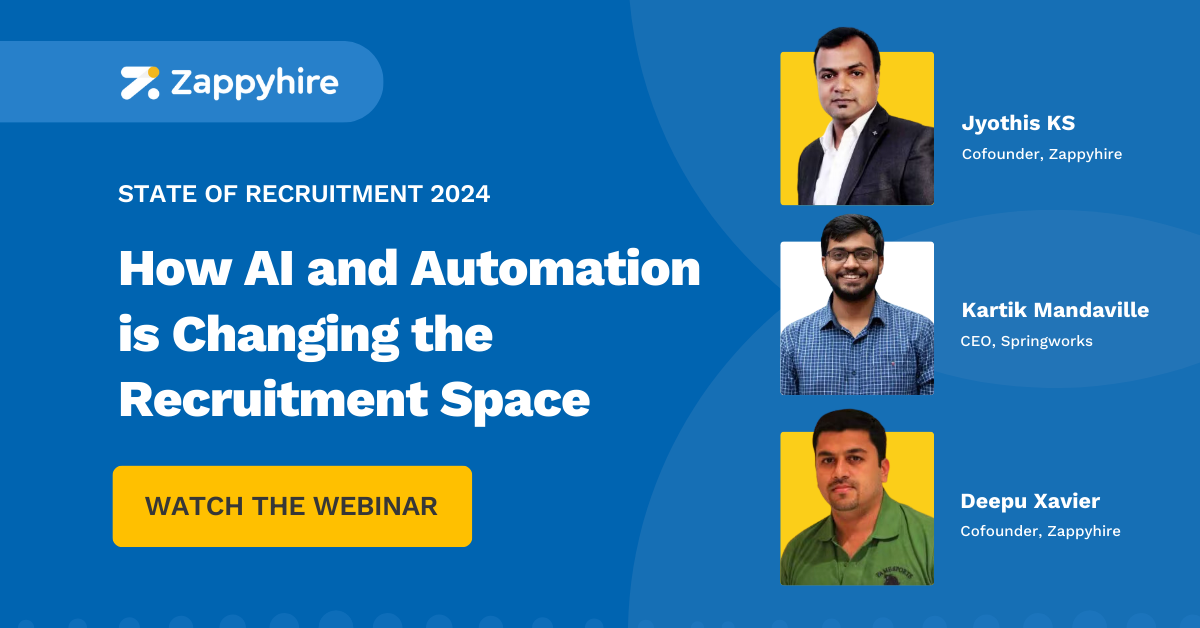
Challenges are an inevitable part of our existence, and the field of recruitment is no different.
The recruitment landscape is one that is constantly evolving, and in such an environment, the ability to recognize and overcome challenges is at the core of effective and efficient recruitment.
The onset of the COVID-19 pandemic, underscored the need for HR professionals to be agile and flexible, adapting to the fast and uncertain changes in the workplace.
In the above instance, they took the lead in ensuring that work continued without interruption, showing their ability to switch to remote hiring as a practical and innovative solution.
Mirroring the principle of “survival of the fittest”, the recruitment arena also adheres to a similar concept. Those who can improvise, innovate, adapt, and overcome challenges are the ones who are guaranteed top talent!
To facilitate that, we’ve collated a list of the top 11 recruitment challenges faced by recruiters and how to overcome them.
This blog aims to help you comprehend and address recruitment challenges – a necessity for businesses striving to attract, retain, and develop top talent!
The ever-evolving landscape of recruitment

The recruitment landscape has seen a significant transformation in recent years, driven by advancements in technology, the advent of different modes of work like hybrid and remote, and evolving candidate expectations.
For instance, in response to the rapid rise of remote/hybrid work post-pandemic, the geographical boundaries of recruitment have expanded, creating opportunities to tap into a global talent pool. Additionally, technology has revolutionized the recruitment process, making it more efficient and data-driven.
While these changes bring forth countless opportunities, the challenges that accompany them are hard to ignore. If you’re a recruiter who faces these challenges on a daily basis and are grappling with the big “how do I overcome this?”, you’re at the right place!
Well then, let’s get right into it!
Top 11 recruitment challenges faced in recruitment and how to overcome them

1. Hiring candidates quickly
The challenge:
Time-to-hire is the amount of time it takes to recruit a suitable candidate, from the point a job opening is posted to the point the offer letter is rolled out.
In a world where top talent stays available for an average of just ten days, a long time-to-hire could potentially result in companies missing out on top-quality candidates.
The consequences:
Delayed hiring can result in lost productivity, increased recruitment costs, and significant challenges in workforce planning.
Plus, a lengthy recruitment process can dissuade applicants from proceeding with the organization in question, a far from ideal situation for the employer.
The solution:
Identify. Address. Overcome.
We suggest you begin by identifying the weak spots in your recruitment operations, address them utilizing data-driven recruitment strategies, streamline the interview process, and implement an efficient applicant tracking system (ATS) like Zappyhire, to overcome the challenge in question.
2. High costs of hiring
The challenge:
Cost-to-hire is inclusive of all expenses incurred during the recruitment process, including the costs associated with advertising the job opening, salaries of the recruitment personnel, and lost productivity.
These costs tend to accumulate quite quickly and can have a noteworthy impact on an organization’s budget.
The consequences:
The high costs associated with recruitment can financially strain an organization, directly impacting its profitability and scalability.
Here’s something to consider: according to the Society for Human Resource Management (SHRM), the average cost per hire in the U.S. is approximately a whopping $4,129!
The solution:
Imagine lightening your workload and having the opportunity to reduce recruitment costs – a true win-win scenario! But how can you make this a reality?
Firstly, reducing recruitment costs involves addressing key factors within the recruitment process, such as optimizing your hiring procedures, streamlining the entire process, and saving valuable time by automating repetitive manual tasks. By taking these measures, you can significantly lower your overall recruitment expenses.
This is where the right leveraging cost-effective talent acquisition software comes in, as it can expedite and enhance these efforts, making the process more efficient and cost-effective!
3. Effectively engaging candidates
The challenge:
Spotting and engaging the right, qualified candidates is crucial for a successful recruitment process. Failure to engage these candidates effectively can lead to missed opportunities and prolonged time-to-fill rates.
Oftentimes it is difficult for recruiters to provide personalized engagement to top talent owing to the vast number of candidates that apply for a single role, resulting in missed opportunities.
The consequences:
Sub-par candidate engagement can boil down to a negative employer brand, increased costs, a smaller talent pool lacking quality candidates, and prolonged time-to-fill rates.
Did you know that making a job application mobile-friendly increases applicants by more than 11%?
This is indicative of how essential it is to engage candidates effectively in order to provide them with a positive candidate experience, thereby reducing the candidate drop-off rate.
The solution:
Personalization and candidate convenience is key – something that cannot be emphasized on enough!
In the same vein, organizations must:
1. Provide personalized communication to connect with candidates individually.
2. Offer feedback to candidates throughout the recruitment process.
According to a LinkedIn survey, a whopping 94% of talent wants to receive interview feedback, but only a mere 41% have received interview feedback before.
Most of the above can be achieved using recruitment chatbots! From personalized communication to being available 24/7 for any queries from candidates, a recruitment chatbot like Zoey, may just be the key to end this particular struggle!
4. Attracting the right candidates
The challenge:
One of the most common challenges recruiters around the globe struggle with is attracting the right candidates for a particular opening at their organization.
This involves the task of identifying prospects whose skills, experience, and values are congruent with the organization’s specific requirements.
The failure to attract the right candidates can result in a misalignment of expectations and capabilities, resulting in issues pertaining to employee retention and employee satisfaction, among others, later down the line.
The consequences:
As mentioned above, bringing in the wrong candidates can result in high turnover rates, increased hiring costs, and disrupted team dynamics.
The solution:
Organizations can enhance the quality of candidates applying to their job openings through numerous strategies.
These include:
1. Creating detailed, unambiguous, and compelling job postings.
2. Leveraging their employer brand.
3. Utilizing data-driven recruitment to effectively target the right candidates.
By adopting these approaches, organizations have a greater chance of attracting high-quality applicants for their roles.
To make things easier, using pre-screening tools give you the opportunity to weed out the applicants that are unfit for your organization early in the pipeline.
Additionally, pre-screening tools also provide recruiters with unmatched candidate insights, helping them make better hiring decisions.
5. Building a strong employer brand
The challenge:
Employer branding is all about molding, presenting and promoting your organization’s reputation as a desirable place to work.
Recruiters consider building a strong employer brand a significant challenge because it takes great effort to create a positive image that can attract and retain the best candidates, especially in a highly competitive market.
The consequences:
A weak employer brand can lead to challenges in attracting high-quality candidates, increased employee turnover, and diminished morale among the workforce.
This holds true, particularly for millennials and Gen Z, who prioritize and are drawn to organizations with strong employer branding.
Remarkably, approximately 86% of employees examine company reviews and ratings before applying for a job, and about 50% won’t even apply to a company with a poor reputation. That’s how crucial it is to ensure a strong employer brand!
The solution:
It’s all about how you market your organization!
Use social proof – develop and promote a strong employer brand through employee testimonials, ensure clear and transparent communication, and promote and facilitate a positive company culture.
6. Data-driven recruitment
The challenge:
Data-driven recruitment involves utilizing data and analytics appropriately to optimize the hiring process.
The challenge here lies in the need for recruiters to access, interpret, and apply data effectively, which can be daunting without the right tools and expertise in place.
Without the proper data collection and analysis tools, and the know-how to interpret this data, recruiters may find it difficult to fully leverage the potential of data-driven recruitment. A lack of a data-driven approach can result in suboptimal hiring decisions.
The consequences:
Without utilizing data appropriately and extensively before making hiring decisions, recruitment choices may end up being based on gut feelings rather than concrete facts.
This can lead to costly mistakes, such as hiring the wrong candidates, which is a significant waste of time and resources.
In fact, the average cost of a bad hire can range from $17,000 to $240,000, indicative of the financial impact of subpar hiring decisions.
The solution:
Implementing data-driven practices, such as making use of predictive analytics, making data-backed decisions, and monitoring key recruitment metrics, involves harnessing various types of data to enhance your hiring decisions.
This can encompass data related to skill sets, candidate matches, personality insights, performance history, language proficiency, domain knowledge and more.
By leveraging this diverse range of data, you can make more informed and precise recruitment choices, ultimately improving your overall hiring process.
7. Eliminating bias
The challenge:
A challenge that is a bit alarming in nature is the unconscious bias that creeps in during the recruitment processes. In this day and age there is no room for such errors in judgment.
This can affect decisions based on factors completely unrelated to the candidate’s qualifications, such as gender, ethnicity, or age and can unfortunately result in unfair hiring practices and missed opportunities for diverse talent.
Did you know, in the US, it is illegal for an employer to discriminate against a job applicant owing to his or her race, color, religion, sex (including gender identity, sexual orientation, and pregnancy), national origin, age (40 or older), disability or genetic information?
The consequences:
A prejudiced hiring process, one of the biggest challenges of recruitment, can lead to a less diverse workforce, high turnover rates among underrepresented groups, and potential legal risks.
A Harvard Business Review study found that people with “white-sounding” names were 50% more likely to get called for an interview than those with “African-American-sounding” names. This is a practice that is more common than one might assume.
The solution:
Employing structured interviews to ensure no one by-passes the system in place, practices like blind resume screening, and diversity training, is integral to reduce bias in hiring decisions.
8. Targeting passive candidates
The challenge:
Passive candidates are individuals who are not actively seeking new job opportunities but might be open to the right offer.
The challenge in recruiting passive candidates lies in the need to identify and engage with individuals who are not actively seeking a job shift.
Recruiters are faced with the challenge of capturing their interest, as these candidates may not respond to traditional job postings.
With close to 73% of candidates being passive job seekers, the challenge lies in creating compelling strategies to reach, engage, and ultimately attract passive candidates, making them a part of the recruitment process.
The consequences:
Organizations can majorly miss out on a significant pool of quality candidates if they fail to employ this practice of targeting passive candidates.
These individuals often have valuable skills and vast experience and expertise but may not respond to traditional job postings.
The solution:
Strategies such as networking, building relationships, employee referral programs, and leveraging social media platforms can go a long way when it comes to engaging and attracting passive candidates.
One could also consider crafting personalized messages and highlighting opportunities that align with their career goals to pique their interest.
9. Efficient and streamlined recruitment process
The challenge:
An inefficient recruitment process can lead to significant bottlenecks, delayed hiring, and a negative candidate experience – elements that belong in recruiter nightmares.
These instances can severely impair a recruiter’s productivity, in turn impacting the organization’s ability to compete for top talent, especially when the competition is cutthroat!
Close to 36% of HR professionals say they don’t have access to adequate technology, causing major inefficiencies in their recruitment operations.
The consequences:
Inefficiencies in recruitment operations can result in losing top candidates to competitors, increased recruitment costs, recruiter fatigue, and prolonged time-to-fill rates amongst other issues.
The solution:
The way forward is to implement automation and technology to streamline administrative tasks, automate repetitive and manual tasks, optimize workflows, and reduce bottlenecks in the recruitment process.
An ATS with tools like Resume Parsers, Recruiting Chatbots, Robotic Video Interviews, among others can aid organizations in this endeavor.
10. Hiring remotely
The challenge:
In the post-COVID era, remote work has more or less become a norm, with the option to work remotely being a significant criterion when looking for a job.
As per a report by Forbes Advisor, as of 2023, almost 12.7% of full-time employees have opted to work from home, while 28.2% work a hybrid model, suggestive of how common the practice has become today.
In this light, recruiting talent who can thrive in a remote or hybrid environment has become a significant challenge.
Ensuring that remote hires are a good fit for the role and can effectively collaborate from a distance is essential.
The consequences:
Hiring the wrong remote candidates who struggle to work independently or cannot adjust to your organization’s way of working remotely, can lead to decreased productivity, disengagement, and difficulty managing remote teams.
The solution:
Consider implementing tailored hiring processes designed for remote work, assess candidates for their adaptability to remote roles, and lay emphasis on assessing their collaboration and communication skills.
Additionally, hiring remotely presents the challenge of assessing candidates’ personalities without in-person interactions. Some recruitment tools use behavioral insights to analyze language and speech, helping you identify personality traits and ensuring cultural fit.
These assessments are imperative for making informed decisions when hiring remotely, going well beyond qualifications to hire individuals who can thrive in your company.
11. Ensuring hiring collaboration
The challenge:
In many organizations, the hiring process involves multiple stakeholders, from HR and hiring managers to hiring team members.
Ensuring effective and seamless collaboration among these stakeholders throughout the recruitment process can be a herculean task, where preventing communication gaps, meeting deadlines, and sharing constructive feedback are crucial to hiring success.
The consequences:
Poor collaboration and communication amongst the stakeholders involved can lead to misaligned expectations, communication breakdowns, and prolonged time-to-fill rates.
The solution:
In view of the aforementioned challenge and its consequences, the first step to ensure hiring collaboration is to establish a hiccup-free collaboration process that eliminates communication gaps and ensures alignment among stakeholders.
This involves establishing clear communication channels and ensuring everyone comprehends the hiring requirements.
With various tools now available to address the numerous specific aspects of recruitment, you can consider adopting collaborative hiring tools to further streamline your hiring operations.
Key Takeaways

- The evolving recruitment landscape brings opportunities and challenges influenced by advancements in technology, remote/hybrid work developments, and evolving candidate expectations.
- There are more than 50 touch points throughout the candidate journey, therefore highlighting the importance of a seamless and engaging recruitment process.
- It is crucial to identify the weak spots in one’s organization’s recruitment process and weed out these weak spots by using hiring technology like ATSs, that address more than one of the above-mentioned challenges, at one go!
- At the end of the day, candidate experience trumps everything else. Happy candidates equals a good recruitment process, thereby increasing the chances of hiring the right candidate.
- Ensuring candidate engagement is crucial and this can be done through personalization of communication.
- Employer brand is a huge determining factor when it comes to recruitment. Company reviews and ratings significantly influence candidates’ decisions; a negative reputation can deter applications.
- Eliminating unconscious bias is a significant challenge in recruitment and taking stringent measures to overcome them is crucial.
- An efficient and streamlined recruitment process can reduce onboarding costs, which average around $1,400 per new employee.
As the recruitment landscape continues to evolve, newer challenges are bound to appear. Yet, if you remain abreast of the latest technology and aren’t hesitant to take advantage of these tools, you’re poised to stay ahead in this competitive arena.
To reiterate, while there are numerous challenges, the opportunities that accompany them are abundant!
If you’ve made it this far, why not get started with a quick demo of our cutting-edge recruitment tools and experience firsthand how Zappyhire can help you overcome these challenges and elevate your talent acquisition game?





